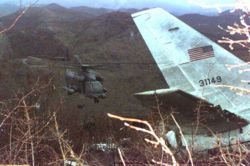PlaneSpottingWorld welcomes all new members! Please gives your ideas at the Terminal.
Boeing T-43
| Boeing T-43 | |
|---|---|
| Boeing T-43A of the USAF 562d Flying Training Squadron | |
| Type | Military transport aircraft |
| Manufacturer | Boeing |
| Introduced | 2001-04-21 |
| Status | Active service |
| Primary user | United States Air Force |
| Developed from | Boeing 737 |
The T-43A is a modified Boeing 737-200 used by the US Air Force. Delivered during 1973 and 1974, the primary mission of the T-43 is as a flying classroom for Navigator training. It has stations onboard for twelve navigator students, six instructors, as well as pilot and co-pilot.
Contents
Overview
Externally the T-43 differs from the civilian aircraft by having more antennas and fewer windows. The student training compartment is equipped with advanced avionics gear identical to that of Air Force operational aircraft. This includes mapping radar; VOR (VHF omnirange) and TACAN (tactical air navigation) radio systems; inertial navigation system; radar altimeter; and all required communications equipment. Five periscopic sextants spaced along the length of the training compartment are used for celestial navigation training. However student navigators are no longer taught celestial navigation.
The aircraft has considerably more training capability than the plane it replaced, the T-29C. Inside each T-43A training compartment are two minimum proficiency, two maxiumum proficiency and 12 student stations. Two stations form a console, and instructors can move their seats to the consoles and sit beside students for individual instruction. The large cabin allows easy access to seating and storage, yet reduces the distance between student stations and instructor positions.
Twelve aircraft of the nineteen originally ordered are still in service for the Air Force in their original role, based at Randolph Air Force Base in Texas and operated originally by the 558th Flying Training Squadron and since 1996 by the 562nd Flying Training Squadron, while two are used for similar purposes by the Air National Guard at Buckley AFB, CO. In addition, one has been modified to a transport aircraft, classified CT-43, and used by US Southern Command for commander transport in South America. At least five converted CT-43A airframes comprise part of the fleet used on Janet flights from Las Vegas to Area 51. http://home.att.net/~jbaugher/1972.html
Incident
On April 3, 1996, an Air Force CT-43 carrying United States Secretary of Commerce Ron Brown and 34 other people, including New York Times Frankfurt Bureau chief Nathaniel C. Nash, crashed in Croatia. While attempting an instrument approach to Cilipi airport, the airplane crashed into a mountainside killing everyone onboard.
The official U.S. Air Force report
The official Air Force accident investigation board report noted several reasons that led to the CT-43 to crash. Chief among the findings was a "failure of command, aircrew error and an improperly designed instrument approach procedure". Notably the inclement weather was not deemed a substantial contributing factor in the crash.
Specifications (T-43A)
General characteristics
- Crew: 2
- Capacity: 19
- Length: 100 ft (30.3 m)
- Wingspan: 93 ft (28.2 m)
- Height: 37 ft (11.2 m)
- Wing area: 980 ft² (91.0 m²)
- Empty weight: 64,090 lb (29,071 kg)
- Loaded weight: 115,000 lb (67,500 kg)
- Powerplant: 2× Pratt & Whitney JT8D-9A turbofan, 14,500 lbf (64 kN) each
Performance
- Maximum speed: 562 mph (904 km/h)
- Range: 3,000 miles (4,830 km)
- Service ceiling: 37,000 ft (11,200 m)
External links
Related content
Related development
Comparable aircraft
Designation sequence
Related lists
- List of active United States military aircraft
- List of military aircraft of the United States
- List of military transport aircraft
Lists relating to aviation | |
|---|---|
| General | Timeline of aviation · Aircraft · Aircraft manufacturers · Aircraft engines · Aircraft engine manufacturers · Airports · Airlines |
| Military | Air forces · Aircraft weapons · Missiles · Unmanned aerial vehicles (UAVs) · Experimental aircraft |
| Notable incidents and accidents | Military aviation · Airliners · General aviation · Famous aviation-related deaths |
| Records | Flight airspeed record · Flight distance record · Flight altitude record · Flight endurance record · Most produced aircraft |


